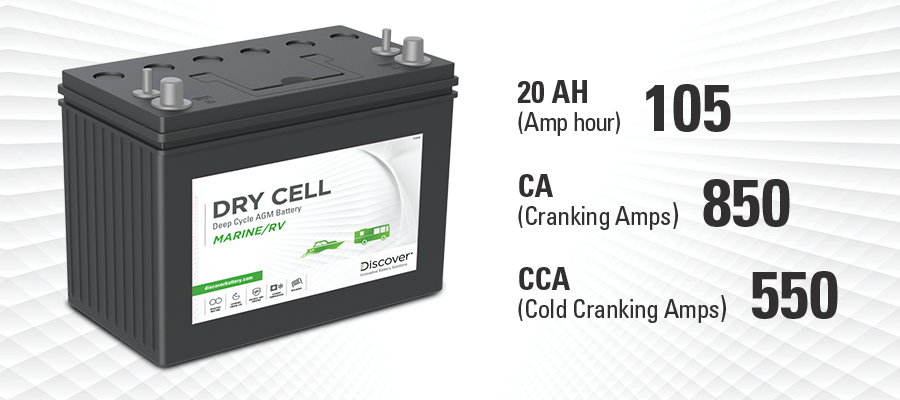
Things to question when making a battery buying decision:
Because of the growing number of performance rating schemes and/or ways to value your buying decision in the market today, it has become challenging to make a decision that doesn’t come with some form of buyer’s remorse at a later date. The following are some of the more obvious things to watch out for when buying;
Some companies rate their Reserve Capacities (minutes that the battery will deliver a discharge current) at 23 amps instead of the industry standard (BCI published) way of establishing Reserve Capacity at 25 amps.
Amp Hour (AH) ratings can be at 5-hour, 10-hour, 20-hour and even 100-hour rates, so make sure you compare the same rate.
Cranking Amps (the ability of the battery to deliver a higher starting current over a shorter period for engine starting) are given at different temperatures, so make sure that you compare the published “Cranking Amps” of each battery at the same temperature. CCA or Cold Cranking Amps at 0°F/-18°C is the industry standard rating. You may see ratings published at CA, MCA, MCCA and HCA. All reputable suppliers will publish the CCA.
Some companies have invented their own rating system by recognizing that the process of comparing Deep Cycle batteries should be simplified. An American-based manufacturer of batteries invented a new labelling system incorporating the “Lifetime Energy Unit” (LEU). This was their attempt to help a buyer determine the lifetime performance and value of any given battery in the market. Simply stated, and in the words of the SANTA FE SPRINGS, CA. manufacturer.
“Lifetime Energy Units signify the number of kilowatt-hours of energy a battery delivers over its lifetime. The bigger the number, the total work the battery can perform. Before introducing LEUs, accurately determining battery performance and value required complex calculations. Engineers compute the true worth of a battery as the total energy it contains, measured in kilowatt-hours (KWH). To derive a number for KWH, they build a curve that profiles the relationship between runtime and the number of cycles. The area under the curve is the total energy the battery delivers over its lifetime. When amp-hours are multiplied by battery voltage, the result is the battery's capacity in watt-hours. The next step - comparing a battery's value - is also simplified. By dividing the LEU by the battery's price, the prospective purchaser obtains a value figure (energy units per dollar) that ensures an apples-to-apples comparison between competing products.”
Discover ultimately rejects this position. As with the variations in determining Reserve Capacity and Cranking Amps mentioned earlier, this is NOT a recognized Battery Council International (BCI) method for rating or comparing batteries as suggested by the manufacturer. The manufacturer leaves out the exact method of determining LEUs, for an exact comparison to be made, which was their stated purpose for establishing the rating. This creates a situation where two suppliers could use two sets of methodologies to determine their respective LEUs, making reasonable comparisons impossible. This implies that the LEU idea or concept in practice is simply a marketing tool with no real scientific basis for engineers, as the manufacturer suggests. LEUs – as a way of helping buyers make an informed decision – would work very well if the buyer was given some additional pieces of data (data that IS available from other manufacturers and that could be used to make meaningful comparisons):
- The exact discharge control methods (test procedures) used in determining the battery's “Cycle Time” (what discharge rate and to what depth is the battery discharged?).
- Whether or not the batteries can be pre-conditioned before running the procedure.
- The resulting ampere hours of power discharged per cycle.
- The recharge control methods (test procedures) before the next discharge procedure.
- The exact control methods used in determining the battery's “LifeCycles.”
- The resulting ampere hours of power discharged over the life of the battery.
In addition to the problems listed above for making good performance comparisons amongst different batteries, using the LEU marketing tool to make a serious value comparison is equally flawed. The value comparison requires more detail. Some, but certainly not all, of the issues to be examined and required in determining value are:
- Time and Supply costs associated with servicing the battery (as recommended by the manufacturer) to ensure it achieves its assumed life
- Costs associated with Workers' Safety and Clothing needs (as recommended by the manufacturer).
- The cost associated with Environmental Issues, Storage and Equipment Damage resulting from the emission of free hydrogen molecules during discharge and recharge.
- Freight/time costs and/or restrictions related to
If these data were known, the buyer could then determine the true energy units per dollar or lifetime energy value as suggested by the manufacturer who introduced the LEU calculation.
